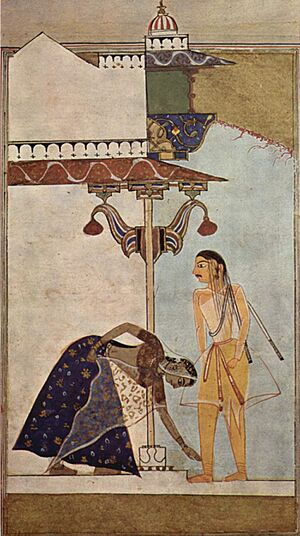Bowing facts for kids
Have you ever seen someone bend forward to say hello or thank you? This action is called bowing. It's a way for a person to bend their body, usually from the waist, to greet someone or show them respect.
A bow can be a small nod of the head or a very deep bend. How people bow and when they do it can be very different around the world. This article is about taking a bow (rhymes with ‘now’). For using a bow (rhymes with ‘no’) in music, see bow (music).
Contents
What is Bowing?
Bowing is a special movement that shows you respect someone. It was originally a way to show deep honor. People bend their body forward to show politeness or thanks.
The way people bow changes a lot depending on their culture. It also depends on the situation they are in.
Bowing in European Cultures
In Europe, bowing is not as common today as it once was. You might see it in very formal situations. For example, someone might bow when meeting a Queen or a very important person.
In the past, men at royal courts often bowed. They would sometimes "bow and scrape." This meant bowing while moving one leg back. It showed extreme politeness, sometimes even too much! This very deep bow was called a "reverence."
Historically, only men bowed. Women would usually do a curtsey to show respect.
Bowing in Performances
Today, you often see bowing after a performance. When people clap after a concert or a play in the theatre, the performers will take a bow. This is like saying "thank you" to the audience for their applause. Both men and women performers bow, though female ballet dancers might still curtsey.
Other European Bowing Examples
In Christian worship, people in churches sometimes bow to the altar. This shows respect for Jesus.
In sports like judo and other martial arts, contestants bow to each other. This shows they respect each other and will follow the rules of the game.
Bowing in Asian Cultures
In some Asian cultures, bowing is much more common. It is a very important part of daily life, especially in Japan.
Japanese people bow a lot, both men and women. They bow to:
- Greet each other
- Say goodbye
- Say they are sorry
- Say "thank you"
- Show that someone else is more important
Different Kinds of Japanese Bows
There are different levels of bowing in Japan. Knowing the right way to bow is very important.
- A small bow of 15 degrees is informal.
- A deep bow of 45 degrees is very formal.
When bowing, Japanese people keep their back straight. Men usually have their hands by their sides. Women often place one hand over the other in front of their body.
Japanese mothers often carry their babies on their backs. This helps children learn to bow even before they can speak! Pupils and teachers at school also bow to one another. Generally, the more important someone is, the deeper the other person bows.
Related pages
Images for kids
-
Different degrees of bowing and prostration, from Eastern Orthodox religious use
-
Judo practitioner (right) performs a bow while seated in seiza.
See also
 In Spanish: Reverencia para niños
In Spanish: Reverencia para niños







